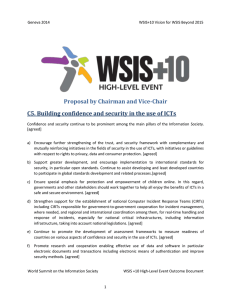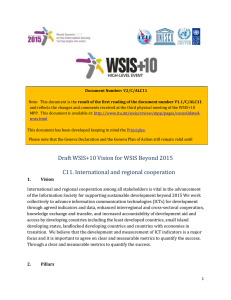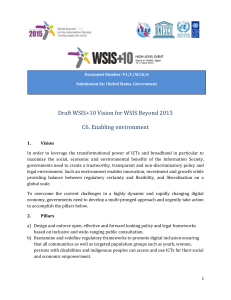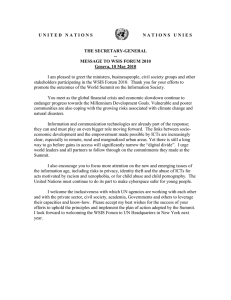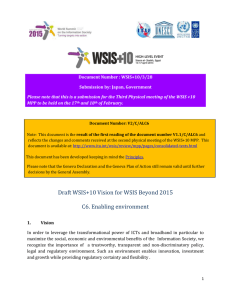Document Number: WSIS+10/4/98 Submission by: UN WOMEN, International Organization
advertisement
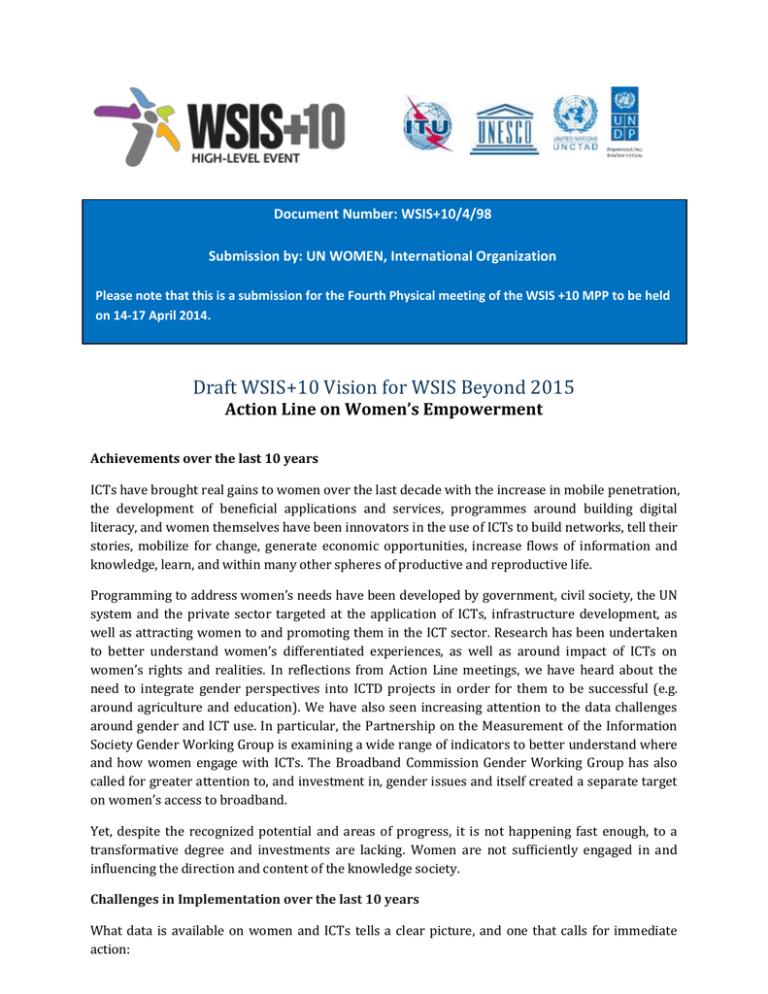
Document Number: WSIS+10/4/98 Submission by: UN WOMEN, International Organization Please note that this is a submission for the Fourth Physical meeting of the WSIS +10 MPP to be held on 14-17 April 2014. Draft WSIS+10 Vision for WSIS Beyond 2015 Action Line on Women’s Empowerment Achievements over the last 10 years ICTs have brought real gains to women over the last decade with the increase in mobile penetration, the development of beneficial applications and services, programmes around building digital literacy, and women themselves have been innovators in the use of ICTs to build networks, tell their stories, mobilize for change, generate economic opportunities, increase flows of information and knowledge, learn, and within many other spheres of productive and reproductive life. Programming to address women’s needs have been developed by government, civil society, the UN system and the private sector targeted at the application of ICTs, infrastructure development, as well as attracting women to and promoting them in the ICT sector. Research has been undertaken to better understand women’s differentiated experiences, as well as around impact of ICTs on women’s rights and realities. In reflections from Action Line meetings, we have heard about the need to integrate gender perspectives into ICTD projects in order for them to be successful (e.g. around agriculture and education). We have also seen increasing attention to the data challenges around gender and ICT use. In particular, the Partnership on the Measurement of the Information Society Gender Working Group is examining a wide range of indicators to better understand where and how women engage with ICTs. The Broadband Commission Gender Working Group has also called for greater attention to, and investment in, gender issues and itself created a separate target on women’s access to broadband. Yet, despite the recognized potential and areas of progress, it is not happening fast enough, to a transformative degree and investments are lacking. Women are not sufficiently engaged in and influencing the direction and content of the knowledge society. Challenges in Implementation over the last 10 years What data is available on women and ICTs tells a clear picture, and one that calls for immediate action: Women’s access gap to the internet globally is around 16%, and as high as 40% in some places. As noted in Doubling Digital Opportunities, women and men use ICTs in different ways with quantifiable gaps increasing for more sophisticated use and content accessed. Only 8% of venture funded startups are led by women and women make up only between 1015% of senior and decision making positions in the ICT sector. Only around 1/3 of national broadband strategies reference gender issues. A report on online media and women’s portrayal showed that stereotypes are even more pronounced in online than traditional media, evidence that offline realities of discrimination are reproducing themselves online. Various reviews, conferences, and consultations have all revealed a number of gaps and challenges. There are strong calls to: Meaningfully integrate women’s needs, perspectives, and capabilities through proper gender analysis and effective learning environments. Position women as equal partners, active agents, content producers, innovators and decisionmakers. Promote women’s access to ICTs in all their forms. This should also include mechanisms to ensure that women do not fall behind with new and rapid technical advances, whether this be broadband, the internet of things, and the like. Better connect and heighten understanding of online and offline realities and surface underlying factors that hinder women’s engagement in the information society. This also includes linking rights offline with enjoyment of rights online and ensuring that harmful practices online – such as violence against women – are prevented or addressed. Involve women to much greater degrees in global Internet governance discussions. Increase attention, dedicated resources, investments, more coherent approaches and accountability measures for women’s empowerment within the information society. Effectively integrate the myriad of issues related to the knowledge society within the work and deliberations of the gender community. Update the WSIS framework in line with standard international practice which treats gender as a mainstreamed issue, as well as one in its own right. 1 Recommendations At present, reference to promotion of gender equality and women’s empowerment in the WSIS outcome documents is found in the declarative and preamble text and to varying degrees within texts of the Action Lines. The WSIS review discussions have strongly pointed to the need to introduce to the WSIS framework mechanisms to help operationalize commitments, support implementation, address some key gaps and enable more holistic treatment of gender issues. Working closely with other action line organization leads, and their respective gender units, work under a Women’s Empowerment Action Line could include: 1. Gender Analysis: Promote the use of “gender analysis” and associated tools and methodologies in the development frameworks, strategies and policies and their implementation. 1 The MDGs, the SDGs, as well as the report of the HLP for post-2015 have acknowledged the need to mainstream, as well as have a discrete goal or section on gender. In the context of the MDGs, having something discrete on gender helped to drive related issues in other goals. In fact, as recent as last week at the SDG Open Working Group meeting the cochairperson’s concluding remarks stated “there was very broad support for a two-pronged approach to reflecting gender equality and women’s empowerment in the SDGs: through a stand-alone goal and mainstreaming gender in other goals.” 2. Holistic Approaches and Structural Issues: Address underlying issues in the information society, such as gender stereotypes and specific threats such as online violence against women and provide analysis and recommendations on gender issues that cut across action lines. 3. Linking the Gender and ICT Communities: Link ICT policy, capacity and programming issues with the work of gender advocates, national women’s machineries and global frameworks. 4. Support to Action Lines and Stakeholders: Provide technical support to the Action Lines and specific stakeholder groups to integrate gender equality into their work in identifying overarching issues, programmatic opportunities, requisite investments and policy interventions. 5. Equal participation of women: Promote equal participation of women in all WSIS related processes and women's voices or representation in panels, committees and bodies constituted for WSIS. 6. Data and Monitoring Progress: Prepare scorecards on Action Line and National level reporting on women’s empowerment. Support and promote the work of the Partnership on the Measurement of the Information Society Working Group on Gender.
